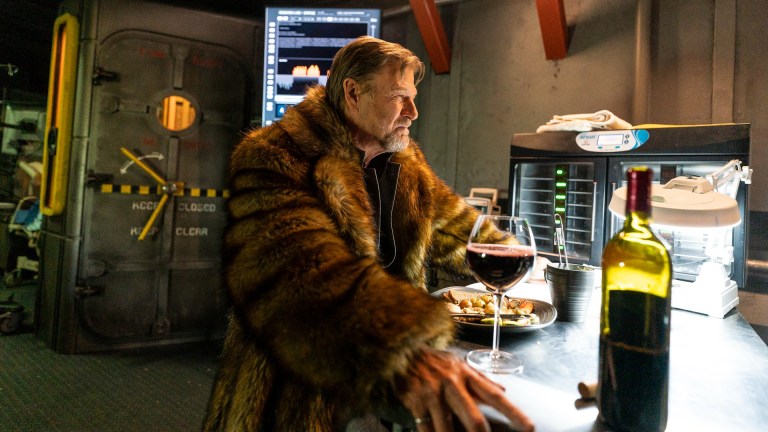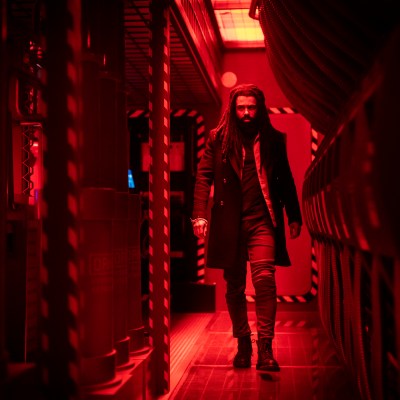Snowpiercer Season 3 Episode 1 Review: The Tortoise and the Hare
Snowpiercer returns with dueling trains, conspiracy theories, and literal treading on thin ice. Will Layton's quest for New Eden be the death of humanity?

This Snowpiercer review contains spoilers.
Snowpiercer Season 3 Episode 1
One of the strongest features of Snowpiercer is the show’s ability to figure out ways to create claustrophobia. Granted, that’s easy on a train; it’s not exactly the sort of environment in which you can spread out and social distance from your neighbors. On the last train, however, that situation is even more dire, especially if you’re in third class or stuck in the tail. The people on board Snowpiercer toil away elbow to elbow with their fellows, making clothes, breaking up ice, cooking and growing food, even entertaining in the club car. There’s not a space to be alone, unless you’re the leader of the anti-Wilford resistance, and that means you’re alone in a room the size and temperature of a meat locker.
The moments when characters are alone, conversely, feel all the more ominous in an environment like that of Snowpiercer, because if no one else is around, that means it’s probably a trap of some sort waiting to be sprung on someone. People who get in the way on Snowpiercer tend to end up suffering. As such, the show’s environment goes a long way towards creating tension; if they’re elbowing through the tunnels, trying to flee from Wilford’s guards, that’s visceral and crowded. If they’re completely alone, minding their own business (or worse, doing something outside of the train), that’s worrying because the scenes are more isolated and thus paranoid.
Whether someone is agoraphobic or claustrophobic, it seems Snowpiercer is ready to use that against them. It’s something of a tale of two trains, with Layton (Daveed Diggs) leading the smaller, faster breakaway train and Wilford (Sean Bean) grinding Snowpiercer under his boot as a result of his mania and need for control. Layton’s train is low on food and running hot, with its inhabitants half-dressed and sweating. Wilford’s train is running slow, low on power and struggling to keep the cold at bay, with its inhabitants crammed into smaller spaces with hundreds of cars shut down and winterized as Snowpiercer battles the elements to keep water flowing. Both trains are dealing with an insurgent element, both trains are struggling to maintain, and both trains seem to have the idea that once they come back together, their problems will all be over.
The between-seasons time jump, as far as those go, is a short enough chronological distance that nothing has really changed on either train, except for a settling into the new status quo, and the litany of technical issues affecting both systems. The first season of Snowpiercer firmly established that the maintenance of the train was about keeping everything in balance, and the introduction and subtraction of Big Alice and Wilford’s group into the shared ecosystem might have tipped the balance to the point where it can’t be recovered, through the anti-Wilford resistance isn’t about to give up, no matter how many times Ruth (Alison Wright) and Pike (Steven Ogg) have to scramble to stay ahead of Wilford’s jackboots.
Scramble is the appropriate phrase to use, because the two characters have to literally scramble through a warren of shipping containers, tunnels, passages, and secret doors to stay one step ahead of Kevin (Tom Lipinski) and Wilford’s goon squad. Christoph Schrewe does a very good job working with the cinematographer to help establish a sense of place for both hide-away locations, while also getting across just how confusingly laid out this train is, with an inordinate amount of secret doors and hidden passageways to keep the messy business of feeding and cleaning up after First Class hidden away from tender sensibilities. The very methods Wilford uses to keep up the illusion—and the very train cars he refuses to jettison because he needs to keep up appearances—give the resistance against him a place to thrive. He may talk a big game, but he likes a game with rules, even if he’s the one that makes them. The image is as important to Wilford as the result.
It’s interesting to see how the problems of the two trains intersect. They are governed in vastly different ways, but have the same problems. The temperature is wrong, there’s not enough food, there are agents from the other train attempting to cause problems. Graeme Manson and Aubrey Nealon’s script emphasizes that quite a bit, and it’s cleverly done. One train can’t go fast enough, one train has to stop and hope it doesn’t overheat and melt down. One train is looking inward for solutions, and the other train is looking outward. Both are following a specific person’s vision, be it Wilford or Melanie (via Layton).
As far as debut episodes go, “The Tortoise and the Hare” doesn’t break a ton of new ground. Like the train itself, there’s only so much novelty that can be found within familiar environs. However, what’s done is executed well, and the actors involved, particularly Tom Lipinski and Steven Ogg, give their roles energy and vitality, with Ogg and Alison Wright making a particularly fun mismatched pairing. Diggs and Bean, as usual, do well with what they’re given, albeit both have more limited screentime this week.
It’s a bit early in the season for high expectations, but Snowpiercer covered the six-month gap pretty neatly, and planted the seeds for future episodes deftly enough, introducing just enough mysteries and mystical visions to bait the hook. Something tells me that New Eden won’t be the hot desert landscape Layton fantasizes about during his lifetime, but anything above ground, stationary, and not cold enough to freeze someone to death instantly is an upgrade.
Especially if Wilford is off on the other side of the world playing conductor.


